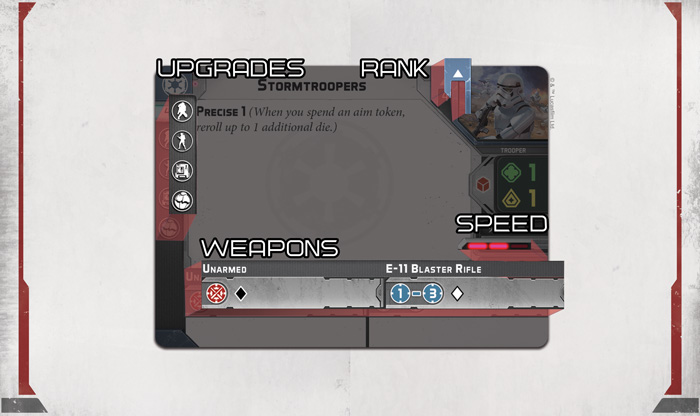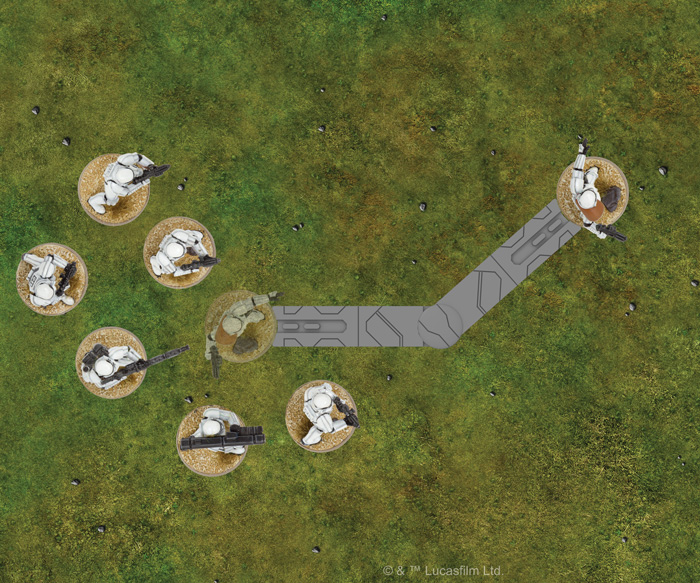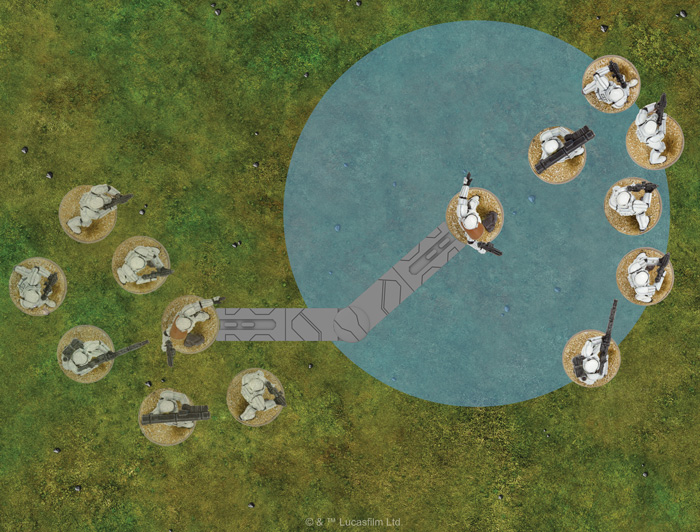Post by Fadril Adren on Dec 18, 2017 17:53:22 GMT -5

“Imperial troops have entered the base!”
–Echo Base transmission, Star Wars: The Empire Strikes Back
From the Galactic Empire’s surface attack on Echo Base to a small team of Rebels maneuvering to catch the Imperial garrison on Scarif off-guard, the movement of troops is a key aspect of every land battle of the Galactic Civil War. Movement and placement are crucial at a grand strategy level, as armies are stationed on key planets or moved to cut off supply lines. But it’s equally important in every battle—and that’s one of the key tactical concerns of Star Wars™: Legion, the upcoming miniatures game of epic ground battles in the Star Wars universe.
Today, we’ll take a closer look at the mechanics of maneuvering your squads of Rebels or Stormtroopers across the battlefield, or sending a few 74-Z speeder bikes zipping forward to strafe the enemy front!

Forward March
Firing your weapons and bringing down enemy units is of paramount importance in Star Wars: Legion—but that doesn’t mean that you can underestimate having your troopers or vehicles in the right place at the right time. Whether you’ve taken cover behind a barricade or you’ve slipped behind an advancing AT-ST to concentrate fire on its weaker rear hull, exactly where you position your troops is one of the aspects that separates veteran commanders from those fresh out of Imperial Academy.
But how are you going to position your miniatures to make the perfect attack in a game of Star Wars: Legion? It all starts when you choose to activate one of your units. As we explained in our last preview, you’ll activate each of your units every round, alternating with your opponent to activate a single unit each turn, either by selecting a unit that was issued orders or by drawing a random order token from your order pool. Regardless of how you get there, your chance to move and position your troops comes when you activate a unit.
Every unit in the game receives two actions when it activates, whether it’s a lowly squad of Rebel Troopers or an iconic villain like Darth Vader. Moving your unit is one of the most common actions that you can take, since it’s your only way of positioning your forces to claim objectives, take advantage of terrain, or line up a devastating enfilade of fire.

Movement in Star Wars: Legion is fast and organic as you use the game’s jointed movement tools to quickly send your squads sprinting across the battlefield. Every unit has a speed shown on the right side of its unit card. This speed determines the length of movement tool that you will use—faster units like the 74-Z Speeder Bikes use the Speed 3 movement tool, while a slower character like Darth Vader can only use the Speed 1 movement tool.

Moving an entire squad of troopers can be accomplished in a matter of seconds. First, you align your unit’s movement tool with any point on the base of the unit leader, adjusting the direction of the movement tool however you choose. Then, you’ll move your unit leader to the end of the movement tool or to any point along its path, as shown above.

After the unit leader has been moved, however, you don’t need to go through a tedious process of measuring movement for every miniature in the unit. Instead, you simply pick up your other miniatures and place them in cohesion with the unit leader! For a unit to maintain cohesion, you simply place your other miniatures within a Speed 1 move of the unit leader. Within that radius, you can place the rest of your squad however you choose, representing your troopers scrambling forward and sticking with their squad.
Vehicle Assault
Movement for your infantry is fluid and open, and it makes perfect sense that your troopers would be able to change direction in an instant, turning a headlong charge into a dive for cover or slipping cautiously around the edge of a bunker. The vehicles that you bring to the battlefield are unmistakably powerful, whether they’re a stomping AT-RT or a lightning-fast 74-Z speeder bike, but their movement is cumbersome and rigid compared to infantry.

The distinctive movement of vehicles is reflected by the restrictions imposed by vehicle bases. Every vehicle base has a notch at the front and back of the vehicle, and when you’re moving this vehicle across the battlefield, you must insert the movement tool into one of these two notches. Even fast-moving vehicles like speeder bikes cannot pivot and turn as quickly as a squad of infantry dashing across the battlefield.
Duck and Cover
Of course, moving is not the only action that your units can take in a game of Star Wars: Legion. Attacking is perhaps the most impactful action—and because of that, we’ll devote our next entire preview to exploring the game’s combat. Still, there are certain actions that you can choose to take that can make you much more likely to hit your target or evade incoming fire.
As an action, you may direct your unit to take aim at their target, receiving an aim token. This token can be spent during an attack to let you reroll two attack dice! Conversely, you may devote one of your actions to hunkering down and avoiding enemy fire by taking a dodge token. Dodge tokens can be spent during combat to negate a single hit that would have targeted your unit!

The Rebel Troopers spend their standby token to make an attack when a 74-Z Speeder Bike moves within range!
Your units may also choose to spend their actions rallying their spirits or preparing for enemy movement. The recover action allows you to remove all suppression tokens from your unit and ready all exhausted upgrade cards—we’ll take a much closer look at suppression tokens in our next preview when we examine combat. You may also hold your troopers in readiness, waiting to react to what your opponent does. By taking a standby action, your troopers gain the power to move or attack when it’s not their activation, reacting to any enemy unit within Range 1-2 taking an action!
Taking Over the Battlefield
The sound of Imperial Stormtroopers tramping onto the battlefield or a salvaged AT-RT pounding forward is part of battle in the Galactic Civil War—as much as the hum of a lightsaber or the hiss of blaster fire.


